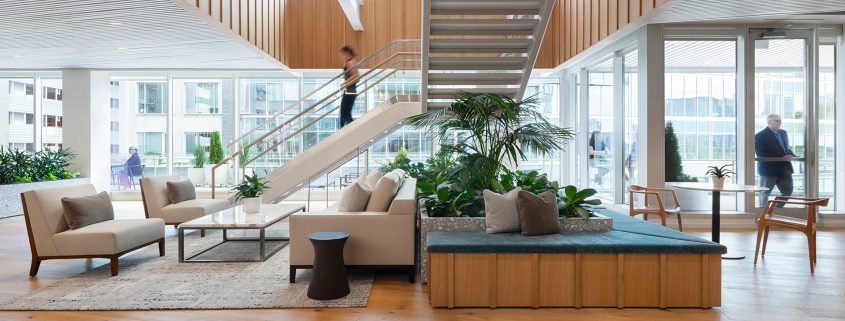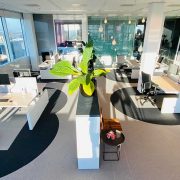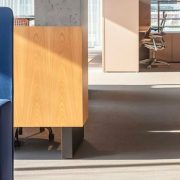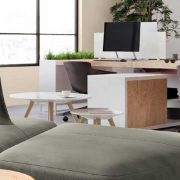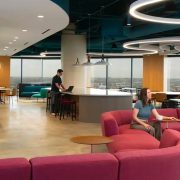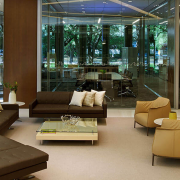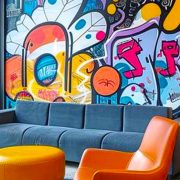Human-Centric Environments
Human-centric environments are sharpening the focus of hybrid workspaces as an incubator for change. The workplace has traditionally been all about business. Transforming spaces into more relatable, compassionate, and understanding of human qualities is what humanizing feels like at work. An environment where comfort, emotion, and human values become part of the design is essential for making the workplace relevant, inspiring, and productive. The shift to inclusive workplaces recognizes diverse needs, not just physically but also cognitively and sensory-wise. This contributes to retention, innovation, and productivity through intentionally designed workplaces that welcome all workstyles.
Human-Centric Environments
- Prioritizing People by focusing on employee work/life balance.
- Fostering Trust & Empathy by creating a culture where individuals feel safe sharing ideas and building meaningful connections.
- Encouraging Collaboration & Creativity through team environments where innovative thinking flourishes.
- Promoting Ownership & Purpose by empowering employees to take initiative and connect their work to a larger organizational purpose.
- Curating Soft Skills that influence how people interact and collaborate in a professional setting.
- Recognizing the human component of collaboration as a strategic imperative for long-term success.
Hospitality Styling
When the hybrid office design metamorphosis began, it was implemented into existing spaces as an afterthought. Encouraging the return to work meant that the design had to become more intentional to attract people back into the workplace community. Combining the comforts of home into a hospitality-rich resimercial design standard empowered engagement. The human-centric environment supports engagement through:
- Welcome hubs that blur the lines between office and cafe culture to create more memorable experiences.
- Adaptable spaces that support both in-person and remote work with a mix of private and collaborative areas.
- Biophilic design aspects like plants, natural light, and outdoor spaces to reduce stress and boost productivity.
- Recharge spaces for focused work and rejuvenation to mitigate monotony and stress.
- Wellness amenities that support healthy breaks, mindful meditation, and nutritious food options.
Blended Physical & Cultural Substance
- Activity-based spaces that repurpose vacant areas into quiet zones, collaborative hubs, meeting rooms, and lounges.
- Modular & adaptable spaces with mobile furniture, moveable walls, and acoustic dividers for flexible environments.
- Flexible work arrangements that include self-scheduling, remote work, and even four-day work weeks.
- Neuro-inclusive environments that support a wide range of cognitive needs with customizable lighting and sound masking.
Authenticity & Cultural Substance
Humanized environments embrace the community where your primary clients, staff, and future associates reside. Connecting to the surrounding community is becoming a very strong component in office design, brand building, and creating ecosystems that go beyond office walls. A culturally sustainable workplace design builds community everywhere it touches:
- Locally-inspired design embraces elements that reflect the unique culture and identity of each office location.
- Curated brand stories through custom art introduce meaningful storylines into the workplace for a more personalized experience.
- Authentic community building through casual social interaction in collaborative, comfortable lounge areas and communal spaces.
- Promote a work-life balance that prioritizes a healthy balance, including wellness rooms and quiet zones.
Why Re-humanizing Creates Relevance
- Boosting performance with natural, comfortable, and inclusive spaces that increase creativity, focus, morale, and energy.
- Creating destination appeal with rich, humanistic environments that give employees reasons to return and stay engaged.
- Supporting innovation through flexible, sensory-rich, and technology-enhanced spaces that cultivate collaboration and inspiration.
- Reflecting your values of sustainability and inclusivity increases talent attraction and brand relevance.
Visit Our New Showroom
Our new showroom is now open, just down the road from our previous location at 4437 Supply Court, Building 4 in Austin. We have plenty of fresh ideas for your office upgrade. Scheduling a consultation with our design team can help you decide where to begin. Collaborative areas are the most logical starting point for human-centric design. We do our best to stay current on office design trends and upgrades, so you don’t have to. Feel free to brainstorm with our team!
Photo from Little Architecture
 INSPIRED WORKSPACES: Our goal is to partner with you on your business journey to help you find viable solutions that navigate current and future trends, immediate needs, and changes that require immediate attention within your workplace. Contact us at 512-448-3769 or experts@officefurniturenow.com
INSPIRED WORKSPACES: Our goal is to partner with you on your business journey to help you find viable solutions that navigate current and future trends, immediate needs, and changes that require immediate attention within your workplace. Contact us at 512-448-3769 or experts@officefurniturenow.com

